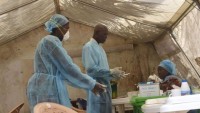New Procedures Using Cartilage From Nose To Repair Knees
| Cory Doyle | | Aug 30, 2014 09:35 PM EDT |
(Photo : Reuters )
With a fairly simple process, nasal septum cartilage can be coaxed in to quickly reproducing. This cartilage producing technique provides the particular patients with their own foundation of joint cartilage. Doctors and scientists have been testing the process of repairing knee and other joints with the cartilage from their own nasal septum.
Like Us on Facebook
Generally cartilage, particularly in a spot where it has been damaged or removed, does not grow back in a very timely fashion. Depending on the body part and the nature of the injury, it may not grow back at all. This is part of the reason why certain joint complications can take so long to heal and or recover from.
Scientists are looking in to using different technologies to aid in the healing process, as well as, actual growth of cartilage tissues. The use of diverse hydro-gels and 3D printers has excelled the process immensely.
However, recently, Switzerland University of Basel researchers are reporting that the body, with help, has the ability to create and store cartilage cells. Thus, giving us the ability to harvest the cartilage from a patient's own nose and it be utilized to fix different joints, specifically their knees.
Nasal septum cartilage cells have minor differences from other types of cartilage cells in the aspect of rapid re-growth. The nasal septum cartilage lacks a certain gene that stops the prevention of cellular re-growth.
In continuing studies, cells and tissue samples are being extracted from 6-millimeter wide plugs of cartilage taken from experimental volunteers. These cells are being multiplied in the lab and then being applied to a piece of biocompatible scaffolding-like material that essentially becomes the framework to the wanted piece of cartilage.
Once the cells have formed and bonded to the biocompatible framework, it's molded into a graft of usable cartilage. The graft is then utilized to repair areas of joints with damaged or missing cartilage.
The cells posses this quality to reproduce throughout the particular patient's whole lifetime, so in theory, treatment on the elderly will be highly possible, as well.
So far, the studies have been producing some high probabilities. The results are described as "very promising", with the nose showing great capabilities of adapting efficiently to it's new form of cellular production.
TagsScience, Science news, New Procedure, Joint Pain, Cartilage, Joint Cartilage Repair, Arthritis, Medical Doctors
©2015 Chinatopix All rights reserved. Do not reproduce without permission
EDITOR'S PICKS
-

Did the Trump administration just announce plans for a trade war with ‘hostile’ China and Russia?
-

US Senate passes Taiwan travel bill slammed by China
-

As Yan Sihong’s family grieves, here are other Chinese students who went missing abroad. Some have never been found
-

Beijing blasts Western critics who ‘smear China’ with the term sharp power
-

China Envoy Seeks to Defuse Tensions With U.S. as a Trade War Brews
-

Singapore's Deputy PM Provides Bitcoin Vote of Confidence Amid China's Blanket Bans
-

China warns investors over risks in overseas virtual currency trading
-

Chinese government most trustworthy: survey
-

Kashima Antlers On Course For Back-To-Back Titles
MOST POPULAR
LATEST NEWS
Zhou Yongkang: China's Former Security Chief Sentenced to Life in Prison

China's former Chief of the Ministry of Public Security, Zhou Yongkang, has been given a life sentence after he was found guilty of abusing his office, bribery and deliberately ... Full Article
TRENDING STORY

China Pork Prices Expected to Stabilize As The Supplies Recover

Elephone P9000 Smartphone is now on Sale on Amazon India

There's a Big Chance Cliffhangers Won't Still Be Resolved When Grey's Anatomy Season 13 Returns

Supreme Court Ruled on Samsung vs Apple Dispute for Patent Infringement

Microsoft Surface Pro 5 Rumors and Release Date: What is the Latest?












